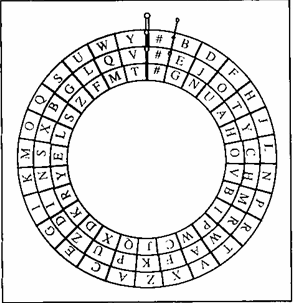Nifty Assignment #2
A Simple Enigma Model
David Reed, Creighton University
Substitution ciphers that encode a message by substituting one character
for another go back at
least as
far as Julius Caesar, who used a rotating character scheme to encode military
orders. This simple type
of
encryption is vulnerable to statistical attacks, however, as anyone who has
solved CRYPTOGRAM puzzles
can
attest. In World War II, the Nazi military employed an encryption scheme that
addressed this weakness
of
simple substitution ciphers. This scheme, implemented by typewriter-sized
devices known as Enigma
machines, gave the Nazis a tactical advantage that greatly contributed to
their early success in the war.
In fact, the eventual breaking of this coding scheme by researchers at
Bletchley Park, England
(including Alan Turing) is hailed as one of the turning points of the war.
Enigma machines used interchangeable rotors that could be placed in
different orientations to obtain different substitution patterns.
More significantly, the rotors rotated after each character was encoded,
changing the substitution pattern and making the code very difficult to break.
The behavior of the rotating rotors can be modeled, in a simplified form, by
a device consisting of labeled, concentric rings.
For example, the model below has three rings
labeled with the letters of the alphabet and '#' (representing a space).

|
To encrypt a character using this model, find the character on the inner rotor
(i.e.,
the inside ring) and note the character aligned with it on the outer rotor
(i.e., the outside ring),
then
find that character on the middle rotor (i.e., the middle ring) and output
the one aligned with it on
the
outer rotor. After a character is encrypted, turn the inner rotor clockwise
one step. Whenever the
inner
rotor returns to its original orientation, the middle rotor turns once in
lock-step, just like the
odometer
in a car.
For example, in this configuration the character 'A' would be encrypted as
'N', since 'A' on the
inner
rotor is aligned with 'H' on the outer rotor, and 'H' on the middle rotor is
aligned with 'N' on the
outer rotor. After performing this encryption, the inner rotor is rotated
clockwise, so the letter 'A'
would
next be encrypted as 'D'.
|
Note that decrypting a message requires following the same steps, only in
reverse (i.e., find the
character on the outer rotor, note the character aligned with it on the middle
rotor, find that character
on
the outer rotor, then output the character aligned with it on the inner rotor).
For this assignment, you are to design a Java class named Enigma
that simulates this three-ring model. You may assume that all Enigma models have the
same outer rotor, as shown in the
above diagram. That is, the outer rotor consists of the 26 capital letters and
the '#' symbol
(representing
a space) in the following clockwise order:
#BDFHJLNPRTVXZACEGIKMOQSUWY. Since the other rotors are
interchangeable, however, their contents and alignment relative to the
outer rotor must be specified when
constructing an Enigma model. For example, the initial settings of the
inner and middle rotors in
the
above diagram are #GNUAHOVBIPWCJQXDKRYELSZFMT and
#EJOTYCHMRWAFKPUZDINSXBGLQV,
respectively. Using an Enigma object, it should be possible to
encode and decode text
messages,
with the appropriate rotation of the rotors occurring after each character
encoding/decoding.
You should also design and implement a graphical user interface that makes
it simple for the user to
specify the rotor settings on an Enigma model, and encode or decode text.
Once you have your model working, test it by decoding the message
OKNNWRDHGERPILRLAMFZF#FMUC
using
the diagram settings.
Note: if you would like to make your own 3-ring Enigma model out of paper, download this
online form,
cut out the rings, and follow the instructions at the site.
